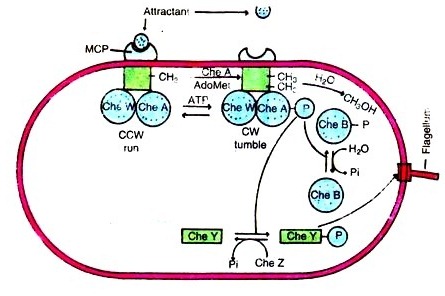In this article we will discuss about the mechanisms of chemo-taxis.
The special proteins called chemoreceptors are supposed to be present in the periplasmic space of plasma membrane that detects the attractants and repellents. These proteins bind to chemicals and transmit signals to the other components of chemo sensing system.
So far about 20 chemoreceptors for attractants and 10 for repellents have been discovered, a few of them take part in the beginning during sugar transport into the cell.
Parkinson (1993) has studied signal transduction schemes of bacteria. E. coli consists of four different chemoreceptors which are often called ‘methyl accepting chemo-taxis proteins’ (MCPs). These four MCPs are localised in patches often at the end of rod-shaped cells. The MCPs act through a series of proteins. The whole responses triggered within 200 mili second. The mechanism of chemo-taxis is shown in Fig. 4.6.
Fig. 4.6 : The mechanism of chemotaxis in E.coli
The MCPs are embedded in plasma membrane in such a way that their major parts are exposed on the both sides i.e. periplasmic side and cytoplasmic side. The periplasmic side consists of a binding site for attractants and repellents. The attractants either directly bind to MCPs or first bind to special periplasmic binding proteins and then to MCP.
The cytoplasmic portion of MCP molecules usually contain about 4-5 methylation sites containing special glutamic acid residues. Methyl’s can be added to these glutamic acid carboxyl group by using S- adenosine methionine as the methylating agent. The chemoreceptor proteins associated with chemotactic responses are CheW, CheA. CheB, CheY and CheZ.
The cytoplasmic side of MCP binds with two chemoreceptor proteins. First it brads to two molecules of CheW proteins which attach to a CheA protein resulting in formation of a full complex (an MCP dimer, two CheW monomer and a CheA dimer).
The chemotactic response arises from a combination of:
(i) The control of CheA phosphorylation by the concentration of attractants/repellent,
(ii) The clockwise rotation promoted by CheY, and
(iii) A feed back regulation circuit.
CheA is stimulated by the MCP, when unbound to an attractant, to phosphorylate itself by using ATP through the process of auto-phosphorylation. Auto-phosphorylation does not occur when attractant binds to MCP. Phosphorylated CheA provides its phosphate to either CheY of CheB protein receptor. If CheY is phosphorylated it migrates to flagellum, interacts with base protein and results in movement of flagellum clockwise (CW).
However, when the concentration of attractant decreases, it results in clockwise rotation and tumbling. The CheZ protein removes the phosphate from CheY in about 10 seconds; when the attractant level changes the bacterium cannot remain in tumbling stage for a long time.
In the absence of attractant or repellent the system maintains the intermediate concentrations of CheA phosphate and CheY phosphate. Consequendy a normal run- tumble swimming state is maintained.
The responses are shown very quickly. This has a short term memory i.e. for a few second of previous attractant/repellent concentration. This adaptation is accomplished by methylation of MCP receptors (Fig. 4.6). Irrespective of the concentration of attractants, methylation reaction is catalysed by the CheR protein.
The phosphorylated CheB protein (a methyl esterase) hydrolytically removes the methyl group from MCPs. The MCP-attractant complex is a good substrate for CheR protein and a poor substrate for CheB. Due to combining of attractant to MCPs the level of CheY phosphate and CheB phosphate decreases and auto-phosphorylation of CheA is inhibited.
This causes in counter clockwise (CCW) rotation and run, and lowers methyl esterase activity resulting in an increase in the process of methylation of MCP. When methylation is increased, it results in alteration in MCP conformation which in turn again maintains the intermediate level of CheA auto phosphorylation.
Therefore, CheY phosphate and CheB phosphate come back to its normal form and attain the normal behaviour of run-tumble. When the attractants are removed, the over methylated MCP stimulates CheA auto phosphorylation. This results in the increase in the level of CheY phosphate and CheB phosphate, and in turn tumbling and de-methylation of MCP receptor.
